
Catalog excerpts
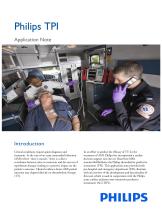
Introduction Critical conditions require quick diagnosis and treatment. In the case of an acute myocardial infarction (AMI) where “time is muscle,” there is a direct correlation between time-to-treatment and the success of reperfusion therapy, leading to a positive impact on the patient’s outcome. Clinical evidence shows AMI patient outcome may depend directly on thrombolytic therapy (TT). In an effort to predict the efficacy of TT for the treatment of AMI, Philips has incorporated a cardiac decision support tool into its HeartStart MRx monitor/defibrillator: the Philips thrombolytic predictive instrument (TPI). This application note provides both pre-hospital and emergency department (ED) clinicians with an overview of the development and functionality of this tool, which is used in cooperation with the Philips acute cardiac ischemia time-insensitive predictive instrument (ACI-TIPI).
Open the catalog to page 1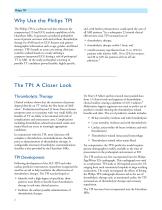
Why Use the Philips TPI The Philips TPI is a software tool that enhances the computerized 12-lead ECG analysis capabilities of the HeartStart MRx. It generates a predicted probability score of patient outcome with and without thrombolytic therapy for AMI based on ECG features and patient demographic information such as age, gender, and blood pressure. TPI’s benefit to acute care setting clinicians could be realized based on a study utilizing a computer-interpreted ECG during a trial of prehospital TT in AMI. In the study, prehospital screening of possible TT candidates proved feasible,...
Open the catalog to page 2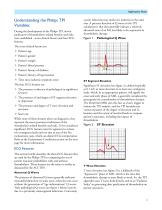
Application Note Understanding the Philips TPI Variables During the development of the Philips TPI, eleven predicators of thrombolysis-related benefits and risks were established - seven clinical factors and four ECG features. The seven clinical factors are: ► Patient’s age ► Patient’s gender ► Patient’s weight ► Patient’s blood pressure ► Patient’s history of diabetes ► Patient’s history of hypertension ► Time since ischemic symptom onset The four ECG features are: ► The presence or absence of pathological or significant Q waves ► The presence of and degree of ST segment elevation or...
Open the catalog to page 3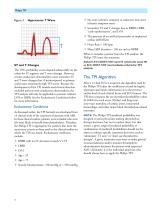
ST and T Changes The TPI’s probability scores depend substantially on the values for ST segment and T wave changes. However, certain conduction abnormalities cause secondary ST and T wave changes that, if misinterpreted as primary, could cause erroneously high TPI scores. Because the development of the TPI models used clinical data that excluded patients with conduction abnormalities, the TPI analysis will only be applicable to patients without LVH or LBBB. See the Exclusionary Conditions below for more information. Exclusionary Conditions As discussed earlier, the TPI formula was developed...
Open the catalog to page 4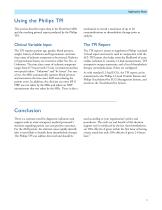
Application Note Using the Philips TPI This section describes input data in the HeartStart MRx and the resulting printed report produced by the Philips TPI. Clinical Variable Input The TPI requires patient age, gender, blood pressure, weight, history of diabetes and hypertension, and time since onset of ischemic symptoms to be entered. Diabetes or hypertension history are entered as either Yes, No, or Unknown. The time since onset of ischemic symptoms ranges from 0-7 hours (with 15 min. increments) and has two special values: “Unknown” and “8+ hours”. For ease of use, the MRx automatically...
Open the catalog to page 5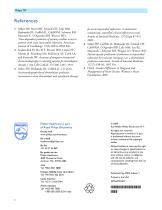
References 1 Selker HP. Raitt MH. Schmid CH. Laks MM. Beshansky JR. Griffith JL. Califf RM. Selvester RH. Maynard C. D'Agostino RB. Weaver WD. Time-dependent predictors ofprimary cardiac arrest in patients with acute myocardial infarction. American Journal of Cardiology. 91(3):280-6, 2003 Feb. 2 Kudenchuk PJ, Ho MT, Weaver WD, Litwin PE, Martin JS, Eisenberg MS, Hallstrom AP, Cobb LA, and Kennedy JW. Accuracy of computer-interpreted electrocardiography in selecting patients for thrombolytic therapy. J Am Coll Cardiol. 17:1486-1491, 1991. 3 Selker HP, Beshansky JR, Griffith JL. Use of...
Open the catalog to page 6All Philips Healthcare catalogs and technical brochures
-
DreamMapper
2 Pages
-
DFM100
6 Pages
-
Trilogy 202
4 Pages
-
Sparq - DS
4 Pages
-
Pinnacle³ Dynamic Planning
8 Pages
-
dStream HeadNeckSpine coil
2 Pages
-
EPIQ 7
20 Pages
-
Compatibility table
4 Pages
-
Vereos Digital PET/CT brochure
21 Pages
-
MobileDiagnost wDR
2 Pages
-
PerforMax
2 Pages
-
ST80i stress-testing system
8 Pages
-
Philips CardioMD IV
12 Pages
-
Diamond Select
2 Pages
-
Cardiology supplies guide
4 Pages
-
BV Pulsera
7 Pages
-
Pinnacle3
6 Pages
-
Azurion accessories
20 Pages
-
fat-free imaging performance
2 Pages
-
Critical Values
2 Pages
-
Patients fi rst performance
6 Pages
-
Freedom of view
3 Pages
-
HeartStart MRx
12 Pages
-
PageWriter TC70
2 Pages
-
Patients first performance
6 Pages
-
BrightView X and XCT
6 Pages
-
Ingenuity TF PET/CT
20 Pages
-
IntelliVue to Go
8 Pages
-
MicroDose SI Product
16 Pages
-
HRC Mask Catalog - US
32 Pages
-
V60
4 Pages
-
Vereos PET/CT
8 Pages
-
MobileDiagnost Opta
4 Pages
-
Philips ProGrade Product
4 Pages
-
Access Dual CT
8 Pages
-
EasyDiagnost Eleva DRF
17 Pages
-
MDE 3D-RX Brochure
6 Pages
-
MDE Brochure
20 Pages
-
Juno DRF Product Overview
4 Pages
-
Philips InnerCool STx+
2 Pages
-
The time has come
24 Pages
Archived catalogs
-
MobileDiagnost wDR_2010
4 Pages


























































